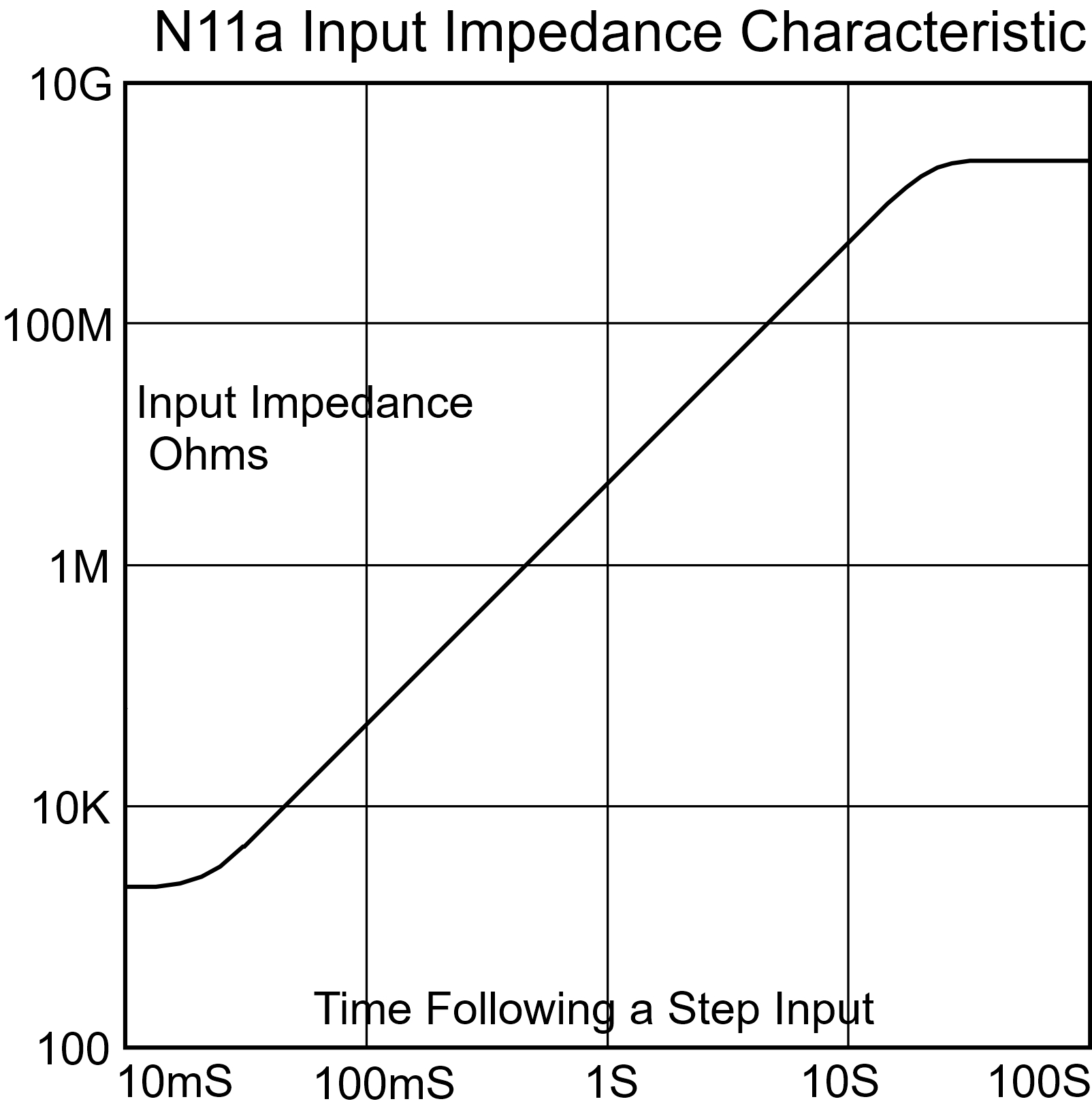Please note that we have temporarily suspended production of this model.

- DESCRIPTION
Description
The EM DC Nanovoltmeter model N11a is the result of years of development in the measurement of very low level DC potential. All the experience gained from the EM range of Nanovoltmeters has gone into the design of the N11a.
Special care has been taken to ensure that the input stage causes the least disturbance to the subject being measured, and the N11a is designed to operate in sensitive circuits at very low levels. With a little care, it is possible to resolve levels approaching 100 picovolts, with an input impedance which increases to over 1000 M ohm. If the N11a is used with a digital voltmeter, 100 picovolt bits may be displayed with a minimum of flicker. The instrument is also designed to have a high degree of linearity.
One of the very important features of the N11a is its ability to measure sources with a wide range of impedance, by following the source ‘Johnson’ noise characteristic closely from 10 ohms to over 100 Kohm. This means that the N11a, while remaining at room temperature, may be used efficiently to measure a source at helium temperature, and even at helium three temperature for some measurements. (See the graph of noise voltage against source resistance)
The excellent stability of this instrument makes it ideal for long term drift measurements, and it may be connected to a recorder and left unattended for long periods.
The six position low pass filter gives the operator control over the response time and reduction of noise from the circuit being measured.
A calibrated offset voltage control is provided, with an 11 position multiplier switch, giving a maximum back off capability of plus and minus one millivolt. This measures small changes in comparatively large signals. The level of input which can be offset on any range will be limited only by the resolution of the calibrated potentiometer, i.e., better than 0.01%.
The pure copper input terminals ensure that the very high thermal stability of the input amplifier is maintained, and also that connection to the instrument may be made easily.
There are two outputs at the rear of the instrument, one direct and the other isolated. When a high linearity is required, the direct output should be used, if possible, although the isolator also has a good linearity.
The N11a is battery operated from internal chargeable batteries and so has the advantage of complete isolation. This instrument is engineered to a very high standard and comes complete with a plug on terminal shield.
- SPECIFICATION
Specification – D.C. Nanovoltmeter Model N11a
Range
Input 1. 12 ranges. +/-10nV fsd to +/- 3mV fsd
Input 2. +/- 10mV fsd to +/- 300V fsdAccuracy
Direct Output. +/- 0.2%
Isolated Output. +/- 0.5%
Meter. +/- 1.5%Linearity
Direct output better than 100 ppmZero Drift
Better than 500pV per degree C.Noise
Equivalent noise resistance approximately 10 ohms. Noise voltage depends on filter setting, e.g., filter time constant ten seconds gives peak to peak noise voltage of approximately 250 picovolts with the input short circuitedSource Resistance
With a source resistance of less than 10 ohms, the instrument noise is substantially constant down to zero ohms. With source resistance from 10 ohms to over 100 Kohm, the instrument adds insignificantly to the source noise. Above about 100 K ohm the instrument noise increases at about 20 dB per decade of source resistance. The N11a will operate with sources up to about 1 M ohm.Resolution
Approaching 100 picovolts.Input Impedance
Input 1. Greater than 30 M ohm, three seconds after a step input, increasing with time to over one G ohm.
Input 2. 10 MohmOffset Current
Adjustable to zero at the front panel. Temperature coefficient better than 1 pA per degree C.Response Time Constant
Depends on setting of filter and range. Minimum: 100 milliseconds. Maximum: 50 seconds.Filter
Six position low pass filter operated by a switch on the front panel.Offset
Ten turn potentiometer calibrated 0-1000 with 11 position switch giving maximum offsets of plus and minus 100nV, 1uV, 10uV, 100uV, 1mV and a ‘0’ position. Resolution. Better than 0.01%. Accuracy. Better than 0.5%.Series Mode Rejection
Greater than 80dB at 50Hz.Outputs
Direct and isolated outputs give plus and minus 1 V for full scale deflection. Amplifier gain equals the reciprocal of the range setting in volts.Isolation
Input to case or output. Greater than 100 M ohm.Connectors
Input. EM low thermal emf terminals for Input 1. Screw posts with 4mm sockets for Input 2 and Case. Outputs. 4mm sockets at rear.Plug on terminal cover provided.
Meter
105mm mirror scale calibrated 10-0-10, and 3-0-3.Power Supply
Internal chargeable batteries, giving more than 50 hours operation from a full charge. Mains powered charger fully charges the batteries in 16 hours with the instrument switched off or 20 hours when in use. Power required 240V or 110 V. 50Hz or 60 Hz. 5 VA. There is an alternative input to charge the batteries from an external, low noise, current source. Minimum voltage. 20 V. Battery capacity. 1.2 AH.Dimensions
Width. 314 mm (12.4″)
Depth. 322 mm (12.7″)
Height. 179 mm (7″) Including folded feet.Weight
14 Kg (31 lbs) - GRAPHS


